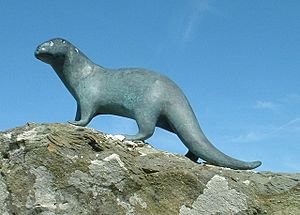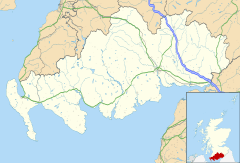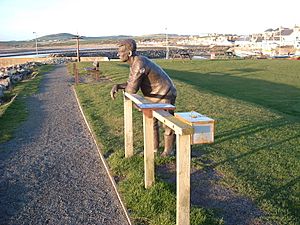Port William, Dumfries and Galloway facts for kids
Quick facts for kids Port William |
|
|---|---|
 View over Port William Harbour |
|
| Population | 460 |
| OS grid reference | NX338435 |
| Council area | |
| Lieutenancy area | |
| Country | Scotland |
| Sovereign state | United Kingdom |
| Post town | NEWTON STEWART |
| Postcode district | DG8 |
| Police | Dumfries and Galloway |
| Fire | Dumfries and Galloway |
| Ambulance | Scottish |
| EU Parliament | Scotland |
| UK Parliament |
|
| Scottish Parliament |
|

Port William (Scottish Gaelic: Cill na Tràghad) is a small fishing village in Scotland. It is located in the area of Dumfries and Galloway. About 460 people live in this village.
Port William has a post office and a small shop for everyday needs. You can also find a takeaway and a restaurant there. For bigger shopping trips, people usually go to Whithorn or Newton Stewart.
Near the village, about one mile away, is Monreith House. This is a beautiful old Georgian mansion. It is a very important historic building.
Contents
Where is Port William Located?
This village sits right on the coast of Luce Bay in Galloway. It is positioned between the small villages of Elrig and Mochrum to the north. To the south, you will find Monreith.
From Port William, you can look out towards the Mull of Galloway. This is the most southerly point of the Scottish mainland. On a clear day, you can even see Ireland and The Isle of Man. The Isle of Man is only about 20 miles away across the Irish Sea.
Port William is about 63 miles west of Dumfries. It is also 23 miles east of Stranraer. Glasgow is further away, about 98 miles to the north.
A Brief History of Port William
The area where Port William now stands was once called Killantrae. This name means 'The Church on the Beach' in Gaelic. It was likely settled after St Ninian arrived in nearby Whithorn. This happened around the end of the 4th century.
The original settlement of Killantrae changed a lot in the 1770s. Sir William Maxwell, a local landlord, decided to build a new village. He completed this new village and its harbour by 1776. He then renamed it Port William. One of the oldest buildings still standing is the corn mill. It used water power from the Killantrae burn.
Port William is known as a "planned village." This means it was designed and built in an organised way. The harbour was very important for local farmers. In the 17th and 18th centuries, the village was also known for smugglers. These were people involved in illegal trading activities.
Famous People from the Area
Gavin Maxwell was a famous Scottish naturalist and author. He is best known for his books about nature. He wrote a lot about otters. Maxwell was born near Port William, at a place called The House of Elrig.
His family still lives in the area today. Their old family estate and grounds are in nearby Monreith.
Port William Inshore Rescue Service
Port William has a special group called the Port William Inshore Rescue Service Action Committee (PIRSAC). This group helps people in trouble on the water. They were one of the first community rescue teams in Scotland.
After some boats had problems in Luce Bay, people asked for a RNLI lifeboat. When this was not possible, the villagers started PIRSAC. They raised money to buy their own rescue boat. This boat started operating in 1979. It still helps people today. The service covers Luce Bay, Wigtown Bay, and the waters between Scotland and the Isle of Man.
The Harbour's Importance
The harbour in Port William was made bigger in 1790 and again in 1848. It was very important for trade. Its commercial importance lasted until the end of World War I.
More work was done on the harbour in the 1980s. A breakwater was built to protect it from the sea. This helps keep the harbour safe.
A statue of a fisherman stands overlooking the harbour. It was originally made of concrete. Now, it has been cast in bronze. This statue was partly paid for by the Millennium Lottery Fund. A plaque in front of the statue has a verse from the poem "Leisure" by W. H. Davies.



